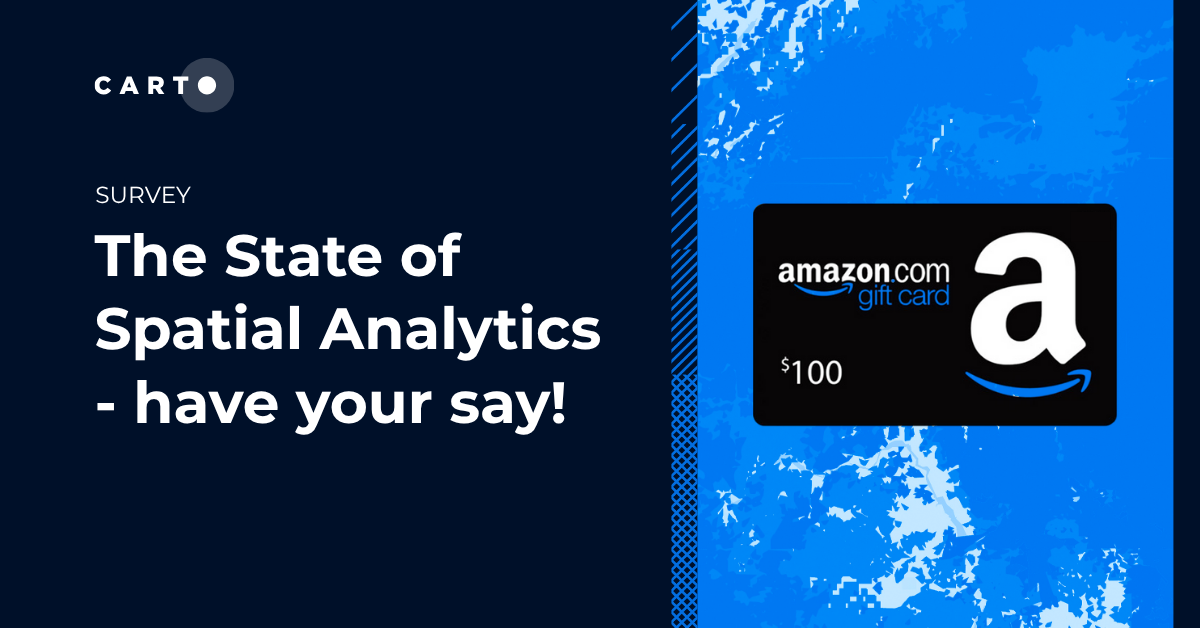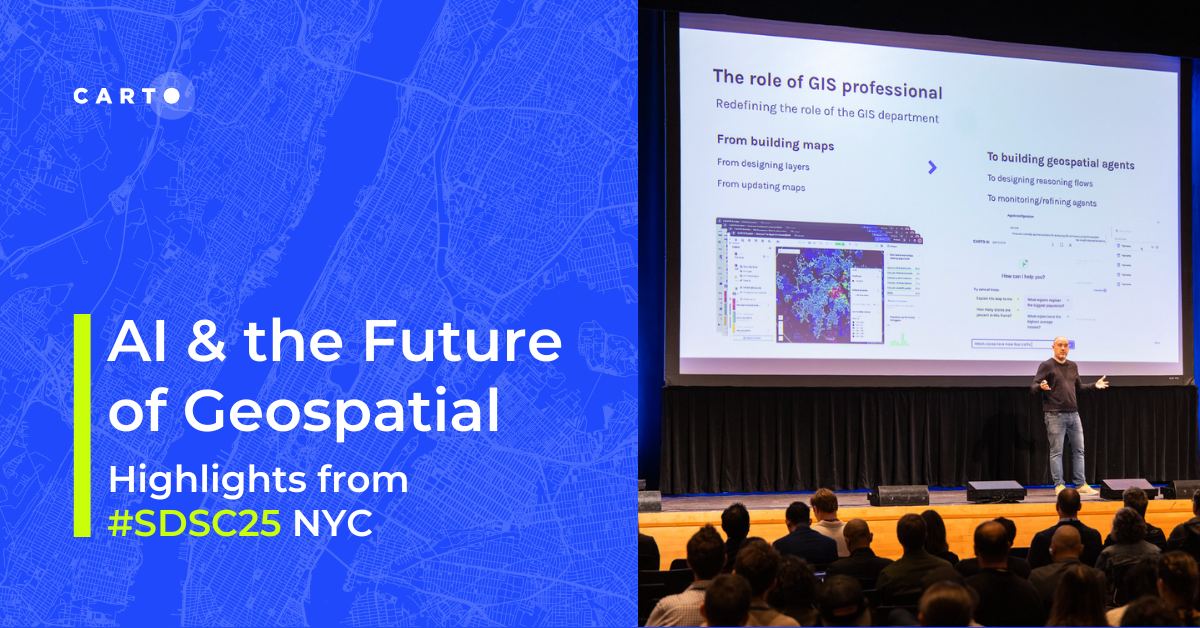What's New in CARTO - Q4 2022

We kick off 2023 excited by the developments we have in our upcoming roadmap, these enhancements will be extremely valuable for our users and partners. Our team is grateful for the ongoing feedback you share with us, this guides us to deliver the most advanced spatial analytics platform available.
Now we have closed an unforgettable year of developments to our cloud native platform, let’s take a deeper look at the releases we have delivered during the final three months of 2022, and how you can extract the most value from these great, new features.
One of the most exciting moments of the last months has been our announcement at the Spatial Data Science Conference in New York of CARTO Workflows, an innovative new tool that enables users of all types and skill levels to harness the power of cloud data warehouses, spatial SQL, and advanced spatial analytics.

CARTO Workflows is built on the premise of making spatial analytics more accessible, providing an analytical modeling tool in a familiar, visual interface. Users can design repeatable analysis using core spatial SQL analysis alongside tools from the CARTO Analytics Toolbox like H3 or Quadbin spatial indexes, routing, geocoding, Data Observatory enrichment and more.
Workflows can be scheduled to run at specific times or based on changes to data inputs in remote files or data in your data warehouse. You can create CARTO Builder Maps, export data, send emails, and more as outcomes of Workflows. Each workflow can be parametrized, duplicated, combined, and shared.
CARTO Workflows is currently in a private beta, we will open to public beta in the coming weeks and our goal is to make it generally available towards the end of the first quarter of 2023.
CARTO users can now start leveraging the power of spatial indexes more easily (Quadbin or H3) thanks to some of the new features and improvements launched in the last few months. If you would like to learn more about how spatial indexes can help solve your geospatial use-cases at scale, don’t miss our recently launched Spatial Indexes 101 report.
Users working with spatial indexes have some new added features that will help them create better and more insightful visualizations:
- The possibility to adjust the aggregation resolution for a finer control
- Aggregation operations for categories: MODE to get the most frequent category in the aggregated cells; ANY VALUE to get any of the aggregated categories.
Logarithmic scales are now available as a data classification option in Builder. While they’re available for all types of data sources, a logarithmic scale based on powers of 10 will be the default option for aggregated data sources.

This last quarter we made available under private beta the option for Admin Users to install the Analytics Toolbox in their Snowflake account through a simplified process assisted by the CARTO UI. From the Settings section of the CARTO Workspace users can now install, update and uninstall the Analytics Toolbox for Snowflake without external support. All details for setting up your Snowflake resources and to carry out the installation process can be found in our documentation. If you would like to get access to this new feature while in private beta, please contact us. We plan to release this feature for general availability during the last half of Q1 2023.
Customers relying on PostgreSQL and PostGIS for their geospatial data are now able to create and execute spatial analyses aided by our point-and-click UI directly from Builder. These analyses are created as dynamically generated SQL queries that are pushed down to a PostgreSQL database through a connection. The result can be visualized, used as input for another step of the analysis, or persisted into a new table. The available analyses include intersecting and aggregating data between sources, creating buffers and centroids, clustering, and more.
Additionally, the CARTO Workspace now also supports importing geospatial files through a PostgreSQL connection leveraging our Import API.
In the December release of the Analytics Toolbox for BigQuery, Snowflake and Redshift we added the possibility to configure more options as parameters when executing functions to CREATE_ISOLINES. These new options, which depend on the LDS service provider, allow the user to configure more transportation modes such as truck or bicycle, the possibility of specifying departure or arrival times allowing the creation of reverse isolines, and other options including different routing modes.

Users of Databricks and CARTO have now the possibility to generate spatial index tilesets based on H3 natively in Databricks. With the native support that Databricks introduced for the H3 global grid indexing system and the tiler module of CARTO’s Analytics Toolbox for Databricks users can now process and visualize very large volumes of spatial data stored in the Databricks Lakehouse Platform.
Since mid October, CARTO provides a set of Python packages to allow data scientists to work with our platform from within their Python notebooks. These packages let users work with geospatial data in the cloud without having to leave their Python environment, and taking advantage of all the potential that the Analytics Toolbox provides to execute advanced location-based analytics using Spatial SQL natively within the leading cloud data warehouse platforms.
In November, we announced the availability of our tailored cloud native spatial analytics platform to help CPG brands accelerate their transition to a more data-driven approach to understanding both the where and why of consumers and merchant points of sale. Our offering brings together first-party data on consumers and trade partners, powerful external spatial datasets to enrich understanding, and a set of out-of-the box analysis to drive key CPG route-to-market strategies.
At this time we launched a pre-built spatial application for CPG Customer Segmentation. This customizable app has been developed to power merchant expansion and trade marketing decisions, based on a deep understanding of the network of POS trade areas, competitors and consumer characteristics. It integrates powerful map visualization, 3rd party spatial data and a set of pre-built analytical functions so CPG brands can quickly understand the surrounding trade fabric and assess network expansion opportunities, through an easy-to-use graphical interface.
We also introduced the new CPG module in the Analytics Toolbox for BigQuery with analytical functions for customer segmentation and to find similar locations. The first function allows users to segment their merchants based on their trade area characteristics enriched with our extensive offer of spatial datasets in the Data Observatory. The second, allows users to identify which locations (e.g. merchants, stores) are more similar to a chosen location (e.g. top performers) based on the characteristics of their surrounding trade areas. This can be configured based on demographic features, environmental, nearby points of interest, footfall, etc. In this example we illustrate how to use this new analysis function to solve a common CPG use-case.
We are really excited by this wave of enhancements to the CARTO platform and would like to thank our customers and partners for guiding us on this journey; and remember you can stay up to date on our most recent product releases by checking our What’s New section.
If you would like to find out more about the enhancements we have developed and see the CARTO platform in action, why not sign up to our Quick-Start Training, taking place on Thursday 2nd February @1700 CET (11am EST).
Like to try out these features for yourself? Sign up for our free 14-day trial.















.png)
